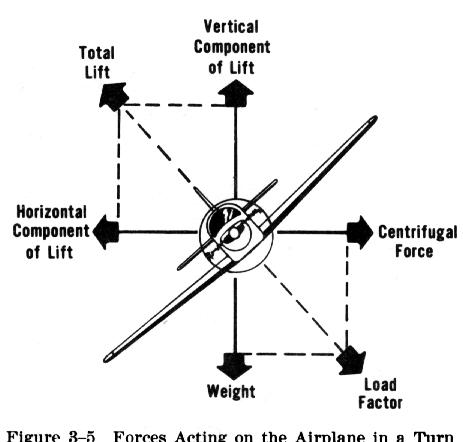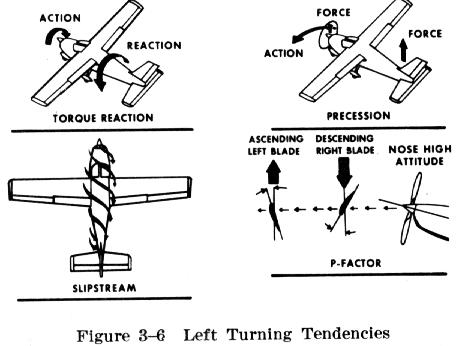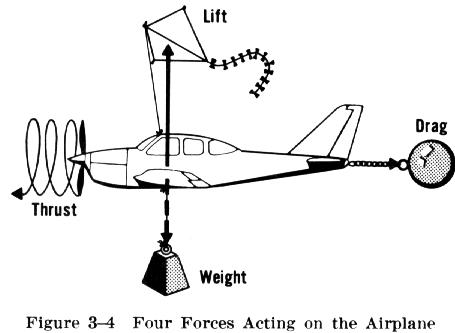Forces
Forces Acting on the Airplane
| While the airplane is propelled through the air and sufficient
lift is developed to sustain it in flight, there are certain other forces
acting at the same time (Fig. 3-4).
Every particle of matter, including an airplane, is attracted downward
toward the center of the earth by gravitational force. The amount of this
force on the airplane is measured in terms of weight. To keep the airplane
flying, lift must overcome the weight or gravitational force. The development
of lift and thrust was explained earlier.
Another force that constantly acts on the airplane is called drag. It
is the resistance created by the air particles striking and flowing around
the airplane when it is moving through the air. Airplane designers are
constantly trying to streamline wings, fuselages, and other parts to reduce
the rearward force of drag as much as possible. The part of drag caused
by form resistance and skin friction is termed parasite drag since it contributes
nothing to the lift force. |
|
A second part of the total drag force is caused by the
wing's lift. As the wing deflects air downward to produce lift, the total
lift force is not exactly vertical, but is tilted slightly rearward. This
means that it causes some rearward drag force. This drag is called induced
drag, and is the price paid to produce lift. The larger the angle of attack,
the more the lift force on the wing tilts toward the rear and the larger
the induced drag becomes. To give the airplane forward motion, the thrust
must overcome drag.
In a steady flight condition (no change in speed or flightpath),
the always present forces that oppose each other are also equal to each
other. That is, lift equals weight, and thrust equals drag.
 |
Another force which frequently acts on the airplane is centrifugal
force. However, this force occurs only when the airplane is turning or
changing the direction (horizontally or vertically) of the flightpath.
Newton's law of energy states that "a body at rest tends to remain at rest,
and a body in motion tends to remain moving at the same speed and in the
same direction." Thus, to make an airplane turn from straight flight, a
sideward/inward force must act on it (Fig. 3-5). The tendency of the airplane
to keep moving in a straight line and outward from a turn is the result
of inertia and it results in centrifugal force. Therefore, some impeding
force is needed to overcome this centrifugal force so the airplane can
move in the desired direction. The lift of the wings provides this counteracting
force when the airplane's wings are banked in the desired direction. This
is further discussed in this chapter in the section on Turning Flight.
Since the airplane is in a banked attitude during a properly executed
turn, the pilot will feel the centrifugal force by increased seat pressure,
rather than the feeling of being forced to the side as is experienced in
a rapidly turning automobile. The amount of |
force (G force) felt by seat pressure depends on the rate of turn. The
pilot will, however, be forced to the side of the airplane (as in an automobile)
if a turn is improperly made or the airplane is made to slip or skid.
One other force which will affect the airplane during certain
conditions of flight, and which will be frequently referred to in the discussions
on various flight maneuvers, is torque effect or left turning tendency.
It is probably one of the least understood forces that affect an airplane.
 |
Torque effect is the force which causes the airplane to have a tendency
to swerve (yaw) to the left, and is created by the engine and propeller.
There are four factors which contribute to this yawing tendency; (1) torque
reaction of the engine and propeller, (2) the propeller's gyroscopic effect,
(3) the corkscrewing effect of the propeller slipstream, and (4) the asymmetrical
loading of the propeller. It is important that pilots understand why these
factors contribute to torque effect.
One of Newton's laws states, "for every action there is
an equal and opposite reaction." Hence, the rotation of the propeller,
with a clockwise movement (as viewed from the cockpit), tends to roll or
bank the airplane in a counterclockwise (to the left) direction (Fig. 3-6).
This can be understood by visualizing a rubber band powered model airplane.
Wind the rubber band in a manner that it will unwind and rotate |
the propeller in a clockwise direction. If the fuselage is released while
the propeller is held the fuselage will rotate in a counterclockwise direction
(looking from the rear). This effect of torque reaction is the same in
a real propeller driven airplane except that instead of the propeller being
held by hand, its rotation is resisted by air.
This counter rotational force causes the airplane to try
to roll to the left. It will be noted in the case of a real airplane that
the force is stronger when power is significantly advanced while the airplane
is flying at very slow airspeed.
| The second factor that causes the tendency of an airplane
to yaw to the left is the gyroscopic properties of the propeller. Here,
we are concerned with gyroscopic precession which is the resultant action
or deflection of a spinning object when a force is applied to the outer
rim of its rotational mass. When a force is applied to the object's axis,
it is the same as applying the force to the outer rim. If the axis of a
spinning gyroscope (propeller in this case) is tilted, the resulting force
will be exerted 90 degrees ahead in the direction of rotation and in the
same direction as the applied force (Fig. 3-7). That force will be particularly
noticeable during takeoff in a tailwheel type airplane if the tail is rapidly
raised from a three point to a level flight attitude. The abrupt change
of attitude tilts the horizontal axis of the propeller, and the resulting
precession produces a forward force on the right side (90 degrees ahead
in the direction of rotation), yawing the airplane's nose to the left.
The amount of force created by this precession is directly related to the
rate at which the propeller axis is tilted when the tail is raised.
The third factor that causes the airplane's left yawing tendency is
the corkscrewing of the propeller slipstream, acting against the side of
the fuselage and tail surfaces (Fig. 3-6). The high speed
rotation of an airplane propeller results in a corkscrewing rotation to
the slipstream as it moves rearward. At high propeller speeds and low forward
speed, |
|
as in the initial part of a takeoff, the corkscrewing flow is compact and
imposes considerable side forces on the airplane. As the airplane's forward
speed increases, the corkscrew motion of the slipstream loosens or elongates,
resulting in a straighter flow of air along the side of the fuselage toward
the airplane's tail.
When this corkscrewing slipstream strikes the side of the
fuselage and the vertical tail surface at airspeeds less than cruising,
it produces a yawing movement which tends to revolve the airplane around
its vertical axis. Since in most U.S. built airplanes propeller rotation
is clockwise as viewed from the cockpit, the slipstream strikes the vertical
tail surface on the left side, thus pushing the tail to the right and yawing
the nose of the airplane to the left.
The fourth factor which causes the left yawing tendency
is the asymmetrical loading of the propeller, frequently referred to as
P-factor (Fig. 3-6). When an airplane is flying with
a high angle of attack (with the propeller axis inclined), the bite of
the downward moving propeller blade is greater than the bite of the upward
moving blade. This is due to the downward moving blade meeting the oncoming
relative wind at a greater angle of attack than the upward moving blade.
Consequently, there is greater thrust on the downward moving blade on the
right side and this force causes the airplane to yaw to the left.
At low speeds the yawing tendency caused by P-factor is greater because
the airplane is at a high angle of attack. Conversely, as the speed of
the airplane is increased and the airplane's angle of attack is reduced,
the asymmetrical loading decreases and the turning tendency is decreased.



